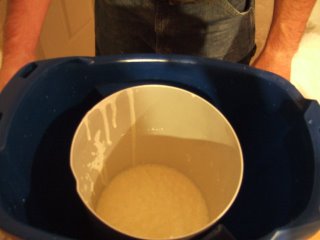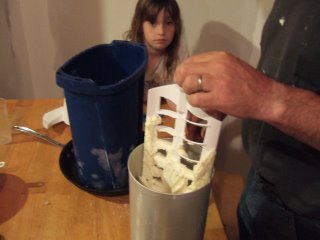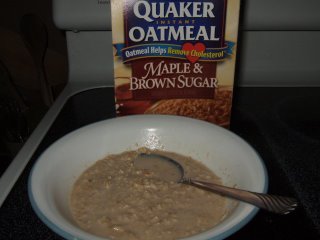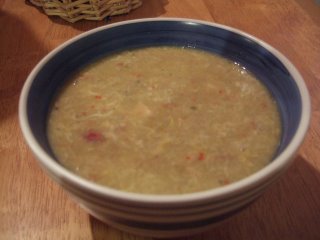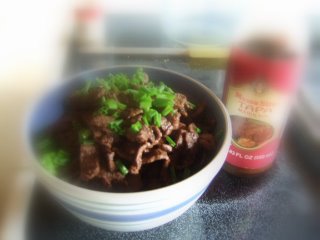
This is my entry for this month's LP theme "Distinctly Pinoy with a TWANG" hosted by ces.
UPDATE:
This cake was featured in GMA-7's 100% Pinoy for the segment on Fusion Dessert.
Here's the video for the said segment. Notice that the website being read by ChefKC for the recipe is
Presenting, the BIBINGKA CAKE with a TWANG!


I had been wanting to try to make bibingka and found several recipes for them. While the most traditional would call for live charcoals above and under the batter, which resulted in toasted surface, I wanted a "tamed" version (for the sake of my intended tasters, my husband and in-laws). I found a recipe which seemed promising, and the original recipe can be found here.
 When I first made them, I modified the recipe, wanting more of a Filipino taste to it by using 1 cup coconut cream and 1 cup milk instead of the 2 cups of milk called for in the recipe, then I added small squares of sliced white cheese on top during the last 5 minutes of baking. I offered one to one of my Pinay friends (I poured into three 8-inch round pans), and several slices to my MIL. We all loved this plain (as in no frosting) bibingka, although my MIL was intrigued by the cheese (she could not identify it and had to ask me what it was!). I loved the smooth texture albeit its heaviness, and the longer it sat in the fridge (less than 1 week, that is), the better it tasted!
When I first made them, I modified the recipe, wanting more of a Filipino taste to it by using 1 cup coconut cream and 1 cup milk instead of the 2 cups of milk called for in the recipe, then I added small squares of sliced white cheese on top during the last 5 minutes of baking. I offered one to one of my Pinay friends (I poured into three 8-inch round pans), and several slices to my MIL. We all loved this plain (as in no frosting) bibingka, although my MIL was intrigued by the cheese (she could not identify it and had to ask me what it was!). I loved the smooth texture albeit its heaviness, and the longer it sat in the fridge (less than 1 week, that is), the better it tasted!BUT, I wanted to experiment more, hoping to offer some sort of an Americanized bibingka cake that I could offer to guests during my birthday (I try not to offer experiments on Pinoy dishes/foods during birthday celebs of my kids or hubby, as they usually have preferences that I try to stick to). Since I have observed that, in contrast to my inkling towards sponge cakes, my in-laws and hubby prefer the crumbly cake (which, to me, sort of represent a cake that is at least one day old). So for that, I thought of experimenting with the bibingka recipe using the ordinary rice flour instead of the sweet rice flour (I figured it would result to crumbly texture, because that's what I have observed with siopao , puto, and bibingka if made with rice flour as opposed to the ordinary flour.)
So my final recipe for the batter was as below, which I poured into two 9-inch round pans:
 Ingredients:
Ingredients:2 cups granulated sugar
1/2 cup (1 stick) butter or margarine
6 eggs
1 cup milk
1 cup premium coconut cream (Thai)
2 teaspoons vanilla extract
3 cup rice flour
2 tablespoons baking powder
Procedure:
Preheat the oven to 350 deg F. Cream the butter and sugar well (around 5 minutes on medium speed). Slow down the speed and add eggs one at a time.

 Meanwhile, mix flour and baking powder. Mix the milk and coconut cream. Add this to the egg-cream mixture, alternating with the dry ingredients a little at a time. Add the vanilla and stir. Pour into two 9-inch round pans. Bake immediately for 35-45 minutes (keep checking!)
Meanwhile, mix flour and baking powder. Mix the milk and coconut cream. Add this to the egg-cream mixture, alternating with the dry ingredients a little at a time. Add the vanilla and stir. Pour into two 9-inch round pans. Bake immediately for 35-45 minutes (keep checking!)Since this is a fusion of Filipino and American cuisine, I did not use banana leaves (I do not have them anyway!) nor charcoal, but used the oven instead.
To make it more Americanized, I prepared JMom's
 SEVEN MINUTE FROSTING
SEVEN MINUTE FROSTING1-1/2 Cups sugar
1/4 teaspoon cream of tartar
1/8 teaspoon salt
2 egg whites
1/4 cup water
2 tablespoons light corn syrup
2 teaspoons vanilla extract
Mix sugar, cream of tartar, salt, egg whites, and water in a pot or bowl over simmering water. Beat steadily over low heat with an electric hand mixer until the frosting stands in peaks, about 5-7 minutes, no more. (Overcooking will make your frosting brittle upon cooling). Remove from heat and continue to beat until thick enough to spread. Add the vanilla before spreading.
(I asked my stepd to taste the frosting, and her reaction was, "Hey, I know this! This is Fluff!" It indeed tasted like Fluff, only not sticky, and the sheen was superb! It is less sweet, too.)
As an additional Pinoy touch, I used sweetened macapuno as filling in between the two layers of cake. I actually mixed it with the 7-min frosting, which turned out to be a disastrous mistake as it made the filling runny, so that when I placed the top layer of cake, it squeezed out most of the filling. Next time, I will use just the macapuno as filling, and the frosting will be used exclusively to cover the whole cake.
I used some sprinkles to make it colorful.
Quite reluctantly, I offered it as dessert to hubby, and HE LIKED IT! I asked his opinion on whether it would be enjoyed by the others in his family as well. DEFINITELY! The next day my MIL came to give me brocolli, and I gave her two slices of the cake to bring home and share with FIL. They loved it!
I will definitely serve this on my birthday in December.
I bet this will also be a big welcome as cupcakes for school functions.

